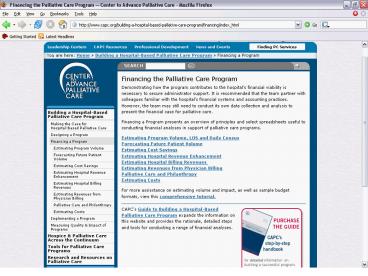Asking for money: One person - PowerPoint PPT Presentation
Title:
Asking for money: One person
Description:
Palliative Care: A Case Example What Does All this Mean from the Patient Perspective? For patients, palliative care is a key to: relieve symptom distress navigate a ... – PowerPoint PPT presentation
Number of Views:118
Avg rating:3.0/5.0
Title: Asking for money: One person
1
(No Transcript)
2
Palliative Care A Case Example
MJ was an 85 year old women with multiple
medical problems including dementia, coronary
disease, renal insufficiency, and peripheral
vascular disease who was admitted to Mount Sinai
with urosepsis. Her hospital course was
complicated by gangrene of her left foot,
sepsis, pressure ulcers, and repeat infections.
She underwent 5 debridements under general
anesthesia. When asked by the primary doctor,
her family consistently said that they wanted
everything done. On day 63 of her
hospitalization, a palliative care consult was
initiated to help clarify the goals of care and
to treat the patients evident pain and
discomfort. She was persistently moaning in pain
and resisting all efforts to reposition or
transfer her or to change her dressings. The
palliative care team met with her son (her health
care proxy) and her two grandchildren. During a
90 minute discussion, the team explored with the
family what they hoped to accomplish for the
patient. The team reviewed the hospital course
and clarified any confusion about her diagnosis
and prognosis. Possible sources of discomfort
and pain were identified. A treatment plan was
initiated which included morphine to treat pain,
discontinuing antibiotics, acetaminophen for
fever, and transfer to the palliative care unit.
The patient was discharged 2 days later when a
bed in her nursing home, this time with a hospice
contract, became available. The family expressed
satisfaction with the resolution of her
hospitalization and continued to visit her daily
in the nursing home where she was reported to be
interactive and comfortable until her death 2
months later.
3
What Does All this Mean from the Patient
Perspective?
- For patients, palliative care is a key to
- relieve symptom distress
- navigate a complex and confusing medical system
- understand the plan of care
- help coordinate and control care options
- allow simultaneous palliation of suffering along
with continued disease modifying treatments (no
requirement to give up curative care) - provide practical and emotional support for
exhausted family caregivers
4
The Clinician Perspective
- For clinicians, palliative care is a key tool to
- Save time by helping to handle repeated,
intensive patient-family communications,
coordination of care across settings,
comprehensive discharge planning - Bedside management of pain and distress of highly
symptomatic and complex cases, 24/7, thus
supporting the treatment plan of the primary
physician - Promote patient and family satisfaction with the
clinicians quality of care
5
(No Transcript)
6
The Hospital Perspective
- For hospitals, palliative care is a key tool to
- Effectively treat the growing number of people
with complex advanced illness - Provide service excellence, patient-centered care
- Increase patient and family satisfaction
- Improve staff satisfaction and retention
- Meet JCAHO quality standards
- Rationalize the use of hospital resources, avoid
costs - Increase bed/ICU capacity, reduce costs
- Invest in a Health Care Advisory Board best
practice with Grade A rating - Improve USNWR hospital ranking
7
(No Transcript)
8
Dr. M, an 89 year old practicing psychoanalyst
- Admitted to the hospital for scleroderma and new
onset kidney failure. - Declined hemodialysis. Palliative care consult
called to assess patients capacity to refuse
dialysis and to assure that she was not suicidal. - Discharged home with hospice on day 5 of hospital
stay. - Did well at home for 4 months, remained in active
clinical practice. - Said good bye to her patients, her son, and her
friends, then died quietly at home 3 days later.
9
Dr. M- How does palliative care deliver quality?
- She received good hospital palliative care- goals
of care assessment and development of a care plan
that met her goals, symptom management. - Transitioned effectively to, and received good
care from, hospice at home- Meticulous symptom
management, psychosocial support from hospice RN,
SW, MD primary doc to patient and her
distressed family and friends. Assured a
peaceful dignified death at home. - Demonstrates how the palliative care quality
continuum works well from the perspective of the
patient and family, the providers, and the
payers.
10
Dr. Ms Care- the Result of Hospice and
Palliative Care Partnership
- As a result of an effective partnership between a
hospital palliative care program and a community
hospice provider, Dr. M. received care that was - Patient centered- goals were defined and met
- Beneficial- symptoms managed, family supported
- Safe- no complications, injuries, errors
- Timely- palliative care from time of diagnosis
of end stage renal disease til death and
bereavement - Efficient- avoided unwanted dialysis,
hospitalizations, surgical procedures, imaging,
transport and cost.
11
of Hospital Based Palliative Care Programs in
the United States, 2000-2004 (Source AHA Annual
Survey)
12
U.S. Hospital Based Palliative Care Programs (AHA
Survey 2004)
13
- No institution is doing everything right. But
we found 10 that are using innovation, hard work
and imagination to improve care, reduce errors
and save money. - But determined people . . . are transforming
the way U.S. hospitals care for the most
seriously ill patients. The engine of change is
palliative medicine. - The field is growing because it pays attention
to the details, says Dr. Philip Santa-Emma It
acknowledges that even if we cant fix the
disease, we can still take wonderful care of
patients and their families. - Newsweek
- Fixing Americas Hospital Crisis
- October 16, 2006































